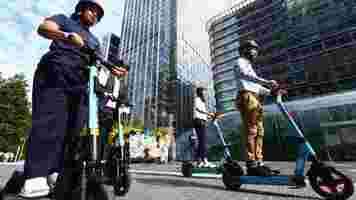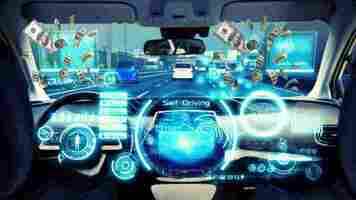Transport for London expands escooter trials
This article was originally published by Christopher Carey on Cities Today , the leading news platform on urban mobility and innovation, reaching an international audience of city leaders. For the latest updates, follow Cities Today on Twitter , Facebook , LinkedIn , Instagram , and YouTube , or sign up for Cities Today News.

Transport for London (TfL) has announced an expansion of the UK capital’s e-scooter trial scheme to cover the borough of Camden.
Over 165,000 trips have been made since the scheme’s launch in June, with Londoners now able to access a fleet of more than 3,400 e-scooters across ten city boroughs.
“We’re really pleased that Camden has joined London’s rental e-scootertrial, and we have worked closely with them to ensure that this expansion meets the needs of everybody in the area,” said Helen Sharp, Transport for London‘s e-scooter Trial Lead.
“Safety continues to be at the heart of our trial and we continue to work with the e-scooter operators, London Councils and the London boroughs to ensure rigorous standards are being met.”
“London’s e-scooter trial continues to provide data and insight into the long-term role that e-scooters could play in a green and sustainable future for the capital, as well as the role that they can play in avoiding a car-led recovery from the pandemic.”
Extensive consultation
Camden is the tenth London borough to join the trial alongside Ealing, Hammersmith & Fulham, Kensington & Chelsea, Richmond, Tower Hamlets (including Canary Wharf), the City of London, Lambeth, Southwark and Westminster.
Councillor Adam Harrison, Cabinet Member for a Sustainable Camden, said: “Rental e-scooters could be one solution, providing an alternative mode of transport that is emission free, potentially reducing the number of motor vehicles on our streets and easing pressures on the transport network.
“We undertook an extensive consultation to hear the views from as many people as possible.”
In a survey, 63 percent of Camden residents indicated their opposition to the trial but council officers attributed the negative response to “public opinion largely based on illegal privately owned vehicles that can in some cases be ridden in a dangerous manner and can potentially be used for criminal activity”.
Legalisation?
The use of privately owned e-scooters on public roads and paths is currently forbidden in the UK, with TfL’s trial schemes the only legal way to use the micromobility devices in the capital.
Last week, a report by UK thinktank Centre for London recommended that e-scooters be completely legalised to cut down on car usage, with research finding that up to two-thirds of car journeys in London could be made via e-scooter in 20 minutes or under.
The city’s Metropolitan Police have stepped up efforts to combat the illegal use of e-scooters, seizing more than 2,500 privately owned devices since the start of the year.
Safety first
The rental e-scooters have a number of safety features, including always-on lights, unique identification numbers, GPS-controlled parking and no-go zones — meaning that they can only be parked in specified locations and cannot be ridden in certain areas.
Three rental e-scooter operators — Lime , Tier and Dott — are currently taking part in the trials.
Both users and non-users of the vehicles can give feedback and report incidents to the firms directly, either by using the contact details displayed on the vehicles or through the operators’ apps.
Data from TfL has revealed that e-scooter operators have reported five serious incidents — out of 165,000 trips — since the scheme began in June.
Do EVs excite your electrons? Do ebikes get your wheels spinning? Do self-driving cars get you all charged up?
Then you need the weekly SHIFT newsletter in your life. Click here to sign up .
San Diego cuts off all streetlight sensors over privacy concerns
This article was originally published by Sarah Wray on Cities Today , the leading news platform on urban mobility and innovation, reaching an international audience of city leaders. For the latest updates follow Cities Today on Twitter , Facebook , LinkedIn , Instagram , and YouTube , or sign up for Cities Today News.

The City of San Diego has deactivated all sensor services, including cameras, on its 3,200 smart streetlights until a new ordinance is in place governing the program.
“At this time, no data can be transmitted from the streetlights,” Gustavo Portela, a spokesperson for the Mayor’s Office, told Cities Today .
San Diego’s smart streetlight program was announced in 2017 , in partnership with GE Current, and touted as “the world’s largest smart city IoT platform”. The sensor installation was part of a broader project to upgrade thousands of streetlights to LED lighting. Through the initiative, more than 3,000 lights became part of the city’s data-gathering infrastructure with the addition of CityIQ nodes, including cameras and sensors. Ubicquia acquired CityIQ and the contract from GE Current earlier this year.
The total cost of the project was approximately US$30 million, to be paid off over thirteen years through the energy savings from the lighting. The sensors made up about US$10 million of the total, the city said.
As well as cost-savings, leaders aimed to use insights from the data captured to improve mobility, parking, public safety and to drive app-led innovation. However, the program has drawn mounting criticism over privacy and surveillance concerns. It sparked further controversy recently relating to San Diego police accessing video footage from streetlights to help solve crimes, including homicides, sexual assaults and fatal accidents, as well as vandalism and looting during protests.
Before cutting off sensor services, “special and limited access to video/image data existed exclusively for the San Diego Police Department (SDPD),” Portela said. This allowed authorized personnel in SDPD to request access to specific video/images within a five-day period at the discretion of the Chief of Police for criminal investigations. Raw video and image data have not been accessible to general city staff or any members of the public, he said.
The city’s contract with Ubicquia expired in June and the company has turned the sensors off until a new deal is in place but it agreed to continue to fulfil police requests for video footage of serious or violent incidents.
But cameras were also switched off earlier this month, after a proposal to pass management of the streetlight program over to the police was quickly scrapped.
“Police have used smart streetlights to hold violent criminals accountable. I support — and proposed — clear rules for this tech, but the City Council stalled on legislation. They won’t approve funds without legislation, so there’s no choice but to turn them off until Council acts,” Mayor Kevin Faulconer tweeted.
He added: “My staff proposed a surveillance policy to the City Council nine months ago. Council still hasn’t adopted one. We’ve seen killers caught, innocent people exonerated, and crimes solved. I’m calling on the Council to vote on surveillance legislation and this tech contract ASAP.”
Where next?
City Council rejected the initial draft policy , calling for a surveillance ordinance to cover more types of technologies and to carry more weight than a policy. The City Attorney reviewed the draft ordinance recently and requested further clarifications.
“The surveillance ordinance is going through the legal review process. It will go to City Council for approval this fall,” said a spokesperson for Council member Monica Montgomery Steppe, who is sponsoring the ordinances to regulate surveillance technology.
Ian Aaron, CEO of Ubicquia, told Cities Today : “We are committed to working with the City of San Diego to make the city smarter, safer and more connected, and we are in continuing dialogue with the city and city stakeholders to ensure the city’s needs are met.”
Making streetlights smart through the addition of sensors is a growing trend in the US and elsewhere. Northeast Group forecasts that US$1.4 billion will be invested in smart streetlighting in the US over the next decade, and US$600 million in additional smart city applications.
The situation in San Diego also comes as several other cities are beginning to introduce stronger oversight of data-gathering technologies, particularly in light of the COVID-19 pandemic, which has increased debate about these systems, and in the wake of the Black Lives Matter movement.
Portland City Council recently unanimously voted to pass two ordinances that prohibit the use of facial recognition technologies by both city departments and private companies. In July, inspired by related initiatives in cities such as San Francisco, Boston and Helsinki, London announced it is developing an Emerging Technologies Charter – a set of criteria that digital innovations should meet if they are deployed in the capital.
Aaron said: “We believe that the surveillance and privacy policy initiatives [San Diego] is working to put in place with input from the community, City Council and the police will serve as a best practice for cities of all sizes.
“Ubicquia is extremely proud of the work we are doing with more than 100 cities across the US and Latin America to make communities smarter, safer and more connected.” He did not specify which are using the CityIQ platform.
SHIFT is brought to you by Polestar. It’s time to accelerate the shift to sustainable mobility. That is why Polestar combines electric driving with cutting-edge design and thrilling performance. Find out how .
Guess who’s the biggest investor in self-driving tech? It rhymes with Bambung
Every year, more and more money is being poured into driverless car tech, with car makers and other huge corporations betting that this’ll be the next big “thing” in the automotive industry.

A new study by Leasing Options, a British car rental firm, reveals which companies have been making the largest investments from 2014 up until now. And, yeah, we’re talking about a lot of money.
In the following graph we can observe the various annual investments per corporation:


Although car manufacturers have made multiple billion dollar investments since 2018, they still haven’t spent as much as tech giant Samsung.
In late 2017, the South Korean company acquired Harman, a US car infotainment and audio company, to develop connected-car technology. To seal the deal, Samsung paid some $8 billion, making it the biggest spender to date.
The biggest competitors from the automotive industry are Toyota and General Motors, coming at the second and third place, respectively.
Over the past six years, Toyota has invested a total of $5 billion, making the biggest move in 2018 when it put down $2.8 billion to form a new dedicated company, called “ Toyota Research Institute-Advanced Development (TRI-AD).”
Similarly, since 2016, GM has spent some $4.9 billion to develop its own self-driving vehicle division, Cruise, which is also backed by Softbank, Microsoft, and Honda, which occupies the last place of the top ten.
Hyundai is the fifth biggest investor, having put down some $3 billion on a number of startups such as Aurora and Envisics.
The Volkswagen Group might come only sixth, but has made the biggest investment since 2018, with $2.6 billion on Argo AI, a driverless tech startup also onwned by Ford as an equal minority investor.
In fourth place, we find another non-car manufacturer fighting for the driverless space.
Softbank, a Japanese multinational conglomerate operating in tech, energy, and finance, has invested close to $3.6 billion in Nuro.ai, GM’s Cruise, and the AV delivery startup Neolix, among others.
While Uber has sold its self-driving taxi division to Aurora, it’s no wonder that it currently occupies seventh place.
What’s actually surprising is that Amazon’s the eighth biggest spender. In 2019, somewhat out of nowhere, Amazon entered the game with its first large investment in Aurora, and then dropped an extra $1.3 billion on the acquisition of another self-driving startup, Zoox.
In ninth place comes Aptiv, having put down $2 billion since 2019. Notably, last year Aptiv partnered up with Hyundai to form a self-driving joint venture called Motional, whose robotaxis will be deployed in various US cities through Lyft’s ride-hailing network , staring in 2023.
You can see the total spending of all the top ten investors in the table below:
Do EVs excite your electrons? Do ebikes get your wheels spinning? Do self-driving cars get you all charged up?
Then you need the weekly SHIFT newsletter in your life. Click here to sign up .